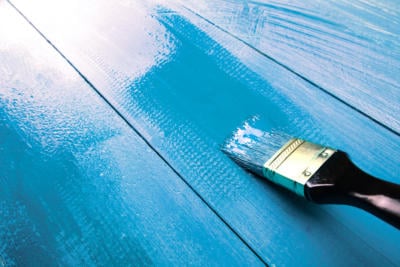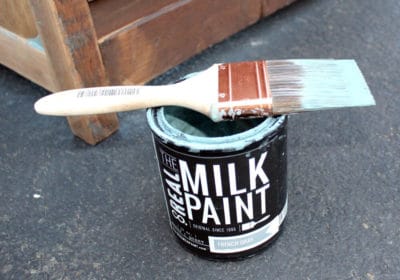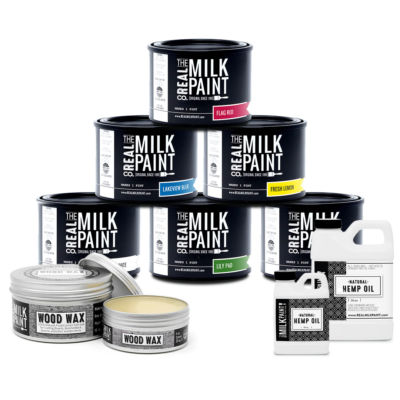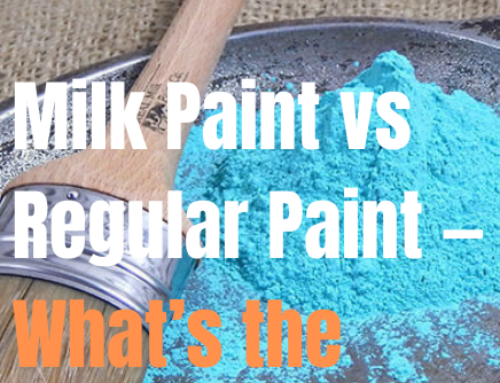The type of paint you decide on should be based on numerous factors, including everything from drying times and sheen levels to indoor/outdoor durability and ease of cleanup. Use this information to determine whether water-based vs. oil-based paint is right for your next project.
Basic Differences Between Water-Based vs. Oil-Based Paint

Several differences exist between water-based vs. oil-based paint that make each medium suitable for different jobs. When you’re deciding whether to use water-based paint or oil-based paint for your painting project, keep these basic differences in mind.
Composition
The major difference in ingredients between water-based paint and oil-based paint comes down to the solvent used in their compositions. Water-based paints like milk paints and latex paints utilize water as a “solvent”, whereas oil paint uses mineral spirits or mineral turpentine.
Volatile Organic Compounds (VOCs)
Volatile organic compounds (VOCs) are the vapor forms of organic solvents that release as those solvents evaporate during the paint drying process. Since water-based paint uses only water as a solvent rather than chemical compounds, it usually has much lower VOC levels.
Sheen Levels
If you want a high-sheen finish, oil-based paints are the way to go, but keep in mind that the sheen dulls over time. Water-based paints like acrylic latex paint, on the other hand, typically have low-sheen finishes that are easier to maintain over the long term than glossy paints. You can always use wood wax or finishing oils to compliment your water-based paint and get that sheen finish.
Durability
Oil paint dries extremely hard for excellent durability, but it lacks elasticity and tends to crack when not properly sealed. Modern water-based paints, however, dry hard enough for durability in most applications and have more flexibility to expand and contract as climate conditions change.
Composition and Characteristics of Water-Based vs. Oil-Based Paint
Understanding the composition and characteristics of each type of paint helps you make better decisions when deciding which to use. Use these tips to discover which is the right paint to stand up to adverse weather conditions, work best on bare walls and retain sheen levels over the long haul.
Water-Based Paint Features
One of the main advantages of water-based paint is that it has less odor than oil-based paint and fewer (if any) VOCs. Latex paint and acrylic latex paint have much lower flammability as well, which makes them safer to work with in confined spaces.
Oil-Based Paint Features
When you want a high-sheen finish that’s simple to scrub, oil-based paint may be for you. This linseed oil medium tends to go on more smoothly than latex paints, and it dries slowly, so you have a longer open working time.
Real Milk Paint as an Example of Water-Based Paint
 When you want a high-quality paint without the typical paint smell, Real Milk Paint ticks all the boxes. This powdered water-based paint mixes at a 1:1 ratio with water for quick deployment on interior walls and mixes with Outdoor Additive when you want to do some exterior painting. A nontoxic formulation made from milk casein makes our milk paint safe for use on food contact surfaces, and the durable matte finish endures time and use with aplomb on items you frequently use around the house.
When you want a high-quality paint without the typical paint smell, Real Milk Paint ticks all the boxes. This powdered water-based paint mixes at a 1:1 ratio with water for quick deployment on interior walls and mixes with Outdoor Additive when you want to do some exterior painting. A nontoxic formulation made from milk casein makes our milk paint safe for use on food contact surfaces, and the durable matte finish endures time and use with aplomb on items you frequently use around the house.
Interior and Exterior Use of Water-Based vs. Oil-Based Paint
In general, water-based paints handle UV light much better than oil-based paint, but that doesn’t mean both paint types don’t have their ideal uses. Put these tips to work when you want to select the best paints to handle high temperatures and temperature changes.
Ideal Applications for Water-Based Paints
Resistance to UV rays makes water-based paint the way to go for exterior painting projects. House painters love how the flexible finish of latex paints helps the medium endure extreme temperatures to keep colors bright and true over time. Water-based paint also works well on interior walls thanks to its low odor, clean color and quick drying times.
Ideal Applications for Oil-Based Paints
Oil-based paint creates a chalky surface and may even crack when exposed to UV light, so this medium works best for indoor applications where durability is needed. With that in mind, house painters often use oil-based formulations to paint trim and baseboards. High-traffic areas of the home like hallways and playrooms may also benefit from oil-based paints.
Benefits of Water-Based vs. Oil-Based Paint
Before you decide between these paint types, figure out which features are most important to you, then go with the type of paint that provides them. Your finished result will, of course, vary depending on which you choose, so knowing what to expect ensures satisfaction with your paint job.
Advantages of Water-Based Paints
The benefits of water-based paints include:
- Dries completely quickly
- Offers long-lasting pigmentation
- Resists UV light
- Goes on easily over existing paint
- Cleans up with soap and water
Advantages of Oil-Based Paints
The benefits of oil-based paints include:
- Dries harder than acrylic latex paint
- Withstands abrasions and staining
- Covers surfaces in fewer coats
- Provides durability in high-traffic spaces
Paint Performance and Cleanup Process
 While the composition, characteristics and benefits of each type of paint are important, performance matters as well. For instance, water-based paints are forgiving when applied on damp surfaces, whereas oil-based paints require a dry surface for bonding to take place. Other differences in the formulations make ease of cleanup a factor in your decision as well.
While the composition, characteristics and benefits of each type of paint are important, performance matters as well. For instance, water-based paints are forgiving when applied on damp surfaces, whereas oil-based paints require a dry surface for bonding to take place. Other differences in the formulations make ease of cleanup a factor in your decision as well.
Ease of Cleanup
Water-based paints like Real Milk Paint have an obvious advantage over both latex paint and oil-based paint thanks to their ease of cleanup. Just a little soap and water is all you need to clean up after a paint job with milk paint. With oil-based paint, however, things get more complicated, requiring specialty thinners or mineral turpentine to remove color from supplies like paintbrushes and buckets.
VOCs and Their Impact
Emitted into the air as paint thinner evaporates and when oil-based paint dries, some VOCs often prove damaging to both individual health and the environment. Good ventilation or air purifiers equipped with activated charcoal filters can mitigate some of the strong smell, but it’s never a good idea to expose yourself to VOCs if you don’t have to, even when applying paint.
Health Concerns
Numerous issues detrimental to human health arise from exposure to glossy paints that use mineral turpentine or mineral spirits as a solvent thinner. Aside from the strong smell of VOCs that sometimes causes headaches and coordination loss, these compounds also cause eye, throat, nose and skin irritation. Some VOCs are considered carcinogens, and without proper ventilation, others may damage the liver, kidneys and nervous system as well.
Environmental Concerns
Concerns with VOCs go far beyond their effects on human health — these compounds also damage the environment. For instance, when oil-based paint containing VOC-heavy solvents isn’t properly disposed of, the compounds may find their way into groundwater and thus into drinking water supplies. These compounds can also move through the soil, rise into buildings and damage airflow quality through a process called vapor intrusion.
Environmental Impact and Sustainability
Doing your part for the environment means learning all you can about the types of paint you use and choosing options that are sustainable. Keep these environmental factors in mind when deciding between water-based vs. oil-based paints.
Water-Based Paints and the Environment
 Low to no VOCs make water-based paints better for the environment than their oil-based counterparts. These formulations include no hydrocarbons, not even natural oils, so they don’t emit fumes that may lower air quality. Likewise, these paints are water soluble, so you don’t usually need to take special pains with disposal. In fact, some options like Real Milk Paint are even biodegradable and compostable for added peace of mind in their environmental friendliness.
Low to no VOCs make water-based paints better for the environment than their oil-based counterparts. These formulations include no hydrocarbons, not even natural oils, so they don’t emit fumes that may lower air quality. Likewise, these paints are water soluble, so you don’t usually need to take special pains with disposal. In fact, some options like Real Milk Paint are even biodegradable and compostable for added peace of mind in their environmental friendliness.
Oil-Based Paints and the Environment
Though oil-based paints typically lose the harsh paint smell once dry, the VOCs they emit aren’t their only environmental consideration. Removal of oil-based paint usually requires specialty thinners that can harm human health and even start fires. Likewise, if disposed of improperly, oil-based paints can penetrate watersheds and pollute groundwater and waterways.
Choosing the Right Paint for Your Project
Understanding the basic differences between water-based vs. oil-based paints helps you make good decisions for future projects. While oil-based paints deliver a higher sheen than water-based paints, their environmental impact and lack of durability when used outdoors makes water-based paints like Real Milk Paint a better option for most home improvement tasks.



